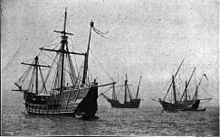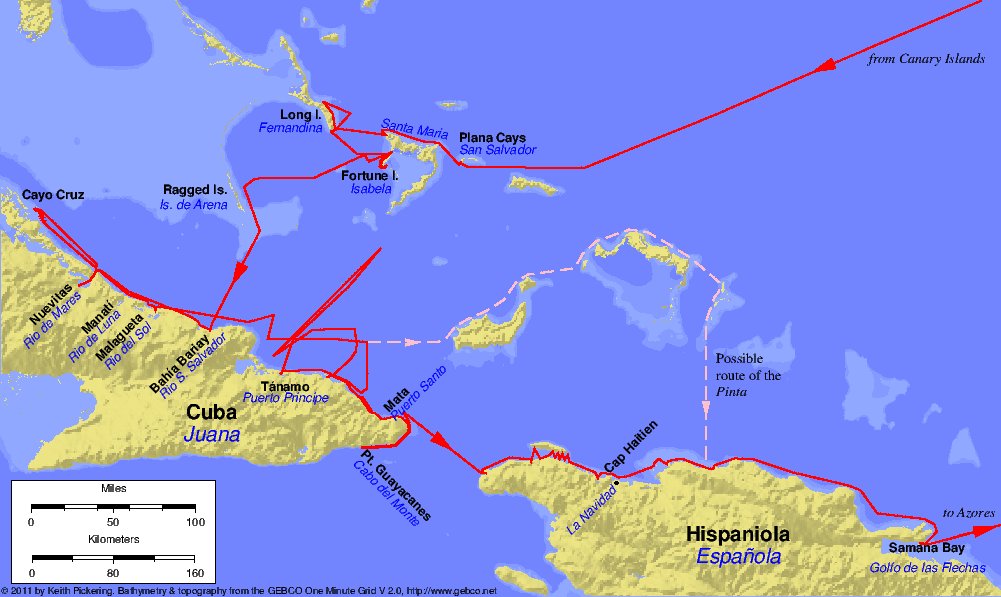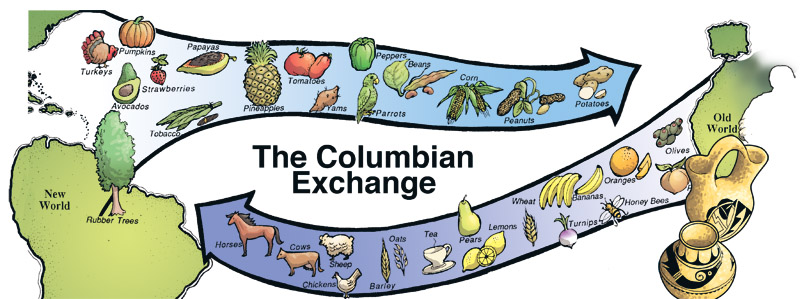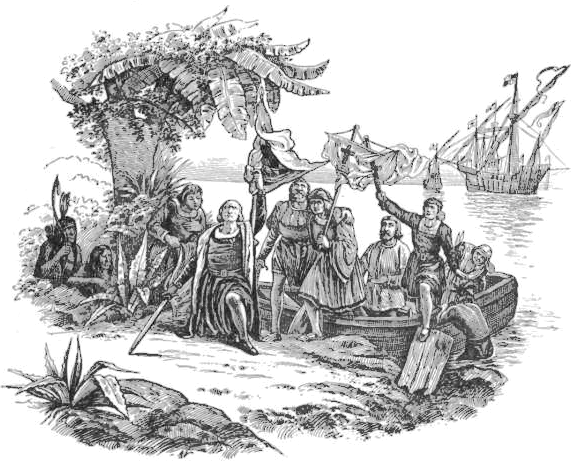


Not Just For Kids
Columbus Day is named in honor of Christopher Columbus for his discovery of the Americas on October 12, 1492. Columbus Day was made a national holiday in 1892, four hundred years after his famous voyage from Spain to the West Indies. While the event is traditionally commemorated on October 12, it is officially observed on the second Monday in October. Columbus Day is also celebrated in Spain and Italy, by some countries in Central and South America, and other Spanish-speaking countries. In the Bahamas, it is called Discovery Day. Christopher Columbus was born in Genoa, Italy, in the year 1451. His name in Italian was Cristoforo Colombo. His father was a weaver of wool in a city of seafarers. Columbus was tall and had blue eyes. They say his red hair had already turned white at the age of 30. He had little formal schooling, but Columbus learned how to make maps and charts, and he was a trained navigator. Columbus knew about the adventures of Marco Polo, who had been to China and brought back riches from the Orient. Columbus made many voyages to the Gold Coast of Africa in his youth. He also sailed north to England, Ireland, and as far as Iceland. By the time Columbus was 30 years old he had gone to sea many times. The study of maps and his own sailing experience led him to believe that Asia could be reached by heading west. Columbus figured that if the earth was round, and Asia stretched so far eastward, it must curve a large part of the way around the earth. Thus, he thought that he could "sail west to get east." However, Columbus did not realize how large the earth actually is, and he did not know an entire continent lay between Europe and Asia! In those days, every country in Europe wished to find a shorter, easier trade route to the Far East, or the Indies. At that time, they had to use slow caravans over long land routes, crossing mountains and deserts to get to Asia's gold, silk, jewels, and spices. While most map makers and seamen thought that a sea route would be impossible, Columbus believed that he could find his way over an uncharted sea to find a new route to the Far East. Columbus tried to persuade King John I of Portugal to give him money for ships, but King John was more interested in finding a way around Africa. So Columbus went to King Ferdinand and Queen Isabella of Spain, who were interested. However, it wasn't a good time because the Spaniards, who were Catholic, were busy fighting the Moors, who were Muslims. Columbus had to wait six years until the Spaniards drove away the Moors and could provide him with ships. Queen Isabella gave Columbus money for the expedition. Columbus asked to be made governor of any lands he discovered, and he also wanted a share of the profits from them. Columbus and his three ships sailed from Spain on August 3, 1492. The ships were named the Nina, the Pinta, and the Santa Maria. The Santa Maria, being the largest of the three, was Columbus's flagship.  The three ships sailed south to the Canary Islands, near Africa. From there, on September 6 they headed directly west into unknown waters. The winds blew steadily and pushed them on their way. For weeks the ships sailed westward. Never before had they been out of sight of land for such a long time. The crew grew restless and discouraged as they sailed farther and farther from home. They were on the verge of mutiny, but Columbus persuaded the men to sail on with the promise that they could turn back in a few days if they didn't find land. Finally, on October 11 they saw several objects float by. Then, just two hours past midnight, land was sighted. At daybreak on October 12, they landed on an island. Columbus named it San Salvador, the island of the Savior, claiming it for Spain. Columbus believed he had found the "Indies," but it was actually an island in the Bahamas. Columbus found villages occupied by native peoples who he called "Indians." In his journal, he wrote: "As I saw that they were friendly to us, and perceived that they could be much more easily converted to our holy faith by gentle means than by force, I presented them with some red caps, and strings of beads to wear upon the neck, and many other trifles of small value, wherewith they were much delighted, and became wonderfully attached to us." The islanders gave Columbus gifts of gold, parrots, cotton thread, darts, pumpkins, corn, and pineapples.  Columbus tried to find out from these people where China and India were so that he could load his ships with gold and spices. The natives took him to other islands, and he discovered Cuba and Hispaniola (Haiti), but he could not find Asia. On Christmas Day, 1492, the Santa Maria ran aground and sank off the coast of Hispaniola. Some men stayed behind and Columbus returned to Spain. Columbus brought six natives along with him - the first "Americans" to be seen in Europe. The rulers of Spain greeted Columbus gave him many honors, and soon he was on his way back with 17 ships and over 1,000 men, including his youngest brother Diego. When he returned to the island of Hispaniola in the fall of 1493, he found their fort burned to the ground and no survivors, but that didn't stop him from establishing more settlements. In 1494, Columbus' brother Bartholomew became commander of the colony of Santo Domingo. In 1498, Columbus reached the coast of Venezuela and explored Central America almost as far as Panama, but thought it was just another island. Columbus also visited Puerto Rico and Jamaica. While Columbus himself had a charming personality and was known as being dignified and honorable, he ended up being deserted by those he trusted. Greed for gold and their feelings of superiority over the natives turned the European settlers into cruel men. Treachery, robbery, and murder were the law in the New World. Troubles in the colonies led to Columbus' arrest in 1500. He was pardoned by King Ferdinand and Queen Isabella, but his enemies were able to reduce the amount of money he was given for his next - and last - voyage in 1502. After dealing with continual hardships, Columbus returned to Spain in 1504, tired and ill. He spent the final years of his life trying to regain his rightful rewards. When Columbus died in 1506, he was poor and unhappy, and he still believed that America was only a group of islands on the way to the Asian mainland. It was not until 16 years later that Ferdinand Magellan's crew completed the first voyage around the world. Then it became obvious that Columbus had discovered a whole new land, four times as large as Europe, and Columbus would be famous after all. Before Columbus' voyage in 1492, no one in Europe, Asia, or Africa knew there were two large continents and millions of people living across the ocean - and those millions of people knew nothing of the rest of the world either. The Eastern and Western Hemispheres would never be the same again as plants, animals, and people began to travel back and forth between the two.  We now know that Columbus and his men were not the first Europeans to discover the Americas. Vikings and perhaps others had sailed to North America centuries earlier. But Columbus was the first European to reach South America, Central America, and the Caribbean. Also, he was the first one to really establish contact between the Americas and the European civilization. His voyages were most notable because they dramatically shaped the future of the New World. Did You Know…? Columbus believed that the most important goal of exploration was to bring Christianity to those who didn't know about it. After his first voyage, he wrote: "I believe in God, and He in me. He has chosen me to bring his message to the people of the East." Discussion Questions For some people, the Columbus Day holiday has become politically incorrect. They argue that Columbus's purpose was not mere exploration or even trade, but conquest and exploitation, for which he used religion as a rationale. Some schools have replaced Columbus Day celebrations with "multicultural" or "ethnic diversity" days. What do you think? Was Columbus's famous voyage an important discovery that led to the advancement of Western civilization and America as we know it today? Or was it an unwelcome takeover and another example of greedy European colonialism? How might the course of history and your way of life be different today if Columbus had not discovered America? Fun Fact Do you know where the word "barbeque" came from? "Barbeque" was what the native islanders called a framework for cooking, smoking, and drying food. Columbus Day Activities 1. Get out a globe or map of the world and trace the route that Columbus took on his first voyage. Do some research to find out what Columbus might have seen along the way. 2. Columbus's name lives on in rivers, cities, and nations. Look in an atlas and see how many places you can find that are named after Columbus. New World Feast Columbus and those who came after him discovered many edible plants in the Americas that were unknown to Europe at the time. The Europeans began to import these plants from the Americas. Using New World plants as the main ingredients, create a menu for a New World Feast. Include an appetizer, a soup, a main course, side dishes, and dessert. For example, you might serve guacamole (made with avocado and tomatoes) and cream of corn soup. New World plants include: corn, potatoes, bell peppers, chili peppers, chocolate, vanilla, lima beans, navy beans, kidney beans, green beans, pumpkins, avocados, peanuts, pecans, cashews, pineapples, bananas, blueberries, wild rice, and tomatoes. BOOKS & WEBSITES
Christopher Columbus
Columbus and the Renaissance Explorers
In Their Own Words: Christopher Columbus
Morning Girl
Who Really Discovered America? www.annieshomepage.com/columbusday.html (Columbus Day history and craft sites.) www.enchantedlearning.com/crafts/columbus (Columbus Day crafts and activities.) www.childfun.com/themes/columbus.shtml (Columbus Day activities, songs, and recipes.) www.computingcorner.com/holidays/columbus/index.html (Information and links about Columbus' voyage, the modern Columbus Day controversy, and more.) www.geocities.com/holidayzone/columbus/index.html (Columbus Day discussion topics, language arts projects, arts and crafts activities, books, songs, poems, and fingerplays.)

ARIZONA | LEARNING FOR LIFE | PRODUCT CATALOG | LINK LIBRARY | ABOUT US | CONTACT
These pages are a continuous work in progress.
Visit my other website - www.ArizonaEdventures.com - click here to explore Arizona!
|
Sign up for my newsletter and get a FREE GIFT! Click here for details.
Thanks for your votes!
and purchase items via our affiliate links. Thank you!
 
|






 L
L K
K